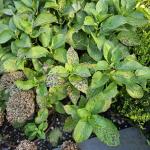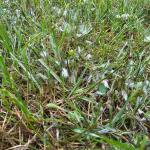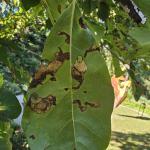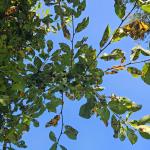UMass Extension's Landscape Message is an educational newsletter intended to inform and guide Massachusetts land care professionals in the management of our collective landscape. Detailed reports from scouts and Extension specialists on growing conditions, pest activity, and cultural practices for the management of woody ornamentals, trees, and turf are regular features. The following issue has been updated to provide timely management information and the latest regional news and environmental data.
Thanks for your continuing interest! Note that we will now shift into the monthly interval for this season, and the next message will be posted on October 13. To receive immediate notification when the next Landscape Message update is posted, be sure to join our e-mail list
To read individual sections of the message, click on the section headings below to expand the content:
Scouting Information by Region
Environmental Data
The following data was collected on or about September 20, 2023. Total accumulated growing degree days (GDD) represent the heating units above a 50ºF baseline temperature collected via regional NEWA stations (http://newa.cornell.edu) for the 2023 calendar year. This information is intended for use as a guide for monitoring the developmental stages of pests in your location and planning management strategies accordingly.
|
MA Region/Location |
2023 Growing Degree Days |
Soil Temp |
Precipitation |
Time/Date of Readings |
||
| Gain since last report |
2023 total |
Sun |
Shade |
|||
|
CAPE |
288 |
2477 |
67 |
64 |
4.62 |
9/20/2023 12:00 PM |
|
SOUTHEAST |
291 |
2536 |
70 |
63 |
3.90 |
9/21/2023 12:30 PM |
|
NORTH SHORE |
254 |
2326 |
62 |
60 |
2.88 |
9/20/2023 9:00 PM |
|
EAST |
281 |
2653 |
68 |
64 |
4.11 |
9/20/2023 4:00 PM |
|
METRO |
254 |
2447 |
60 |
58 |
3.63 |
9/20/2023 6:15 PM |
|
CENTRAL |
256 |
2520 |
62 |
61 |
5.49 |
9/20/2023 7:30 PM |
|
PIONEER VALLEY |
251 |
2576 |
67 |
63 |
4.21 |
9/20/2023 2:00 PM |
|
BERKSHIRES |
202 |
2141 |
63 |
58 |
2.72 |
9/20/2023 6:45 PM |
|
AVERAGE |
260 |
2460 |
65 |
61 |
3.95 |
- |
|
n/a = information not available |
||||||
US Drought Monitor: In this wet, wet season, no drought areas are currently designated in the state of Massachusetts. State map as of Thursday 9/21: https://droughtmonitor.unl.edu/CurrentMap/StateDroughtMonitor.aspx?MA
Phenology
| Indicator Plants - Stages of Flowering (BEGIN, BEGIN/FULL, FULL, FULL/END, END) | ||||||||
|---|---|---|---|---|---|---|---|---|
| PLANT NAME (Botanic / Common) | CAPE | S.E. | N.S. | EAST | METRO W. | CENT. | P.V. | BERK. |
| Heptacodium miconioides (seven son flower) | Full/End | * | Full | Full | Full | Full/End | Full | Full |
| Clematis terniflora (sweet autumn clematis) | Full | Full | Full | Full | Full | * | Full/End | Full/End |
| Polygonum cuspidatum / Reynoutria japonica / Fallopia japonica (Japanese knotweed) | Full/End | Full/End | Full | Full | Full | Full | Full | Full/End |
| * = no activity to report/information not available | ||||||||
Regional Notes
Cape Cod Region (Barnstable)
General Conditions:
The average temperature for the period from Sept. 6 to Sept. 20 was 70°F with a high of 90°F on Sept. 7 (the only 90°F day of the season) and a low of 57°F on Sept. 20. The period started off with hot and humid conditions and dewpoints above 70° from Sept 6–13. Along with the high humidity there was also abundant precipitation, including 6 consecutive days with precipitation. Precipitation totals for the period in Barnstable were over 4.5 inches. The Cape was spared major impacts from Tropical Storm Lee; there were some scattered power outages and relatively minor tree damage. Soil moisture is adequate to excessive. Current soil moisture conditions require extra attention to avoid soil compaction from landscape equipment.
Herbaceous plants seen in bloom during the period include goldenrods (Solidago spp.), asters (Symphotrichum spp.), stonecrop (Sedum spp.), and lily-turf (Liriope muscari). Woody plants observed in bloom during the period include rose-of-Sharon (Hibiscus syriacus), glorybower (Clerodendrum trichotomum), crape myrtle (Lagerstroemia indica), and bigleaf hydrangea (Hydrangea macrophylla).
Pests/Problems:
Box tree moth was recently confirmed in Barnstable County. This is an introduced pest that feeds on boxwood and has the potential to cause extensive damage. Inspect boxwoods for signs of this pest.
Insect or insect damage observed during the period include tupelo leaf miner damage, turpentine beetle and pine tip moth damage to pitch pine, fall webworm, hibiscus sawfly damage on hardy hibiscus, and white grub damage to turf.
Fungal pathogens have thrived under the recent conditions of high humidity and abundant precipitation. The conditions have led to some premature leaf drop on trees like crabapple, birch, callery pear and black cherry. Disease symptoms and signs observed during the period include; beech leaf disease on beech, foliar nematodes on hosta, cercospora leaf spot on bigleaf hydrangea, anthracnose on maple, pear trellis rust on callery pear, and powdery mildew on many herbaceous plants and woody plants. Brown patch, dollar spot, and pythium have been active in turf.
Weeds in bloom include spotted spurge (Euphorbia maculata), lambsquarters (Chenopodium album), Pennsylvania smartweed (Polygonum pensylvanicum), ragweed (Ambrosia artemisiifolia), and crabgrass (Digitaria spp.).
Yellow jackets wasps and bald faced hornets have become more noticeable as they seek out sugary food resources.
Southeast Region (Dighton)
General Conditions:
The passing of Tropical Storm Lee along the Atlantic seaboard over the past two weeks brought rains and a dramatic shift in temperatures. On Thursday, September 7th, we had a daytime high temperature of 92°F. On the morning of Wednesday, the 20th, we had a low of 51°F. The average temperature for the period was 75°F. Overall, we received 3.9 inches of rain. The highest wind speed was 20 mph on both Friday, September 15, and the following Saturday.
Plants in flower: Clematis paniculata (sweet autumn clematis), Polygonum cuspidatum (Japanese knotweed), Vitex agnus-castus (chastetree)
Pests/Problems
Powdery mildew on anthracnose-resistant native flowering dogwood, Cornus florida 'Angel'. Needle cast on Norway spruce.
Local mosquitoes are testing positive for both EEE and West Nile viruses.
North Shore (Beverly)
General Conditions:
The first part of this reporting period saw temperatures above average for this time of the year with day temperatures ranging from the mid-70s to mid 80s and night temperatures ranging from the mid 60s to low 70s. The second half of the two week period was much cooler with day temperatures ranging from the mid 60s to low 70s and night temperatures in the mid 50s. The average daily temperature for these two weeks was 68°F with a minimum temperature of 53°F recorded on September 15 and a maximum of 88°F on September 7. The weather in the first part of the period was cloudy with rain showers on most days. Approximately 2.88 inches of rainfall were recorded at Long Hill during this two-week period. Due to the rains all summer long and the cooler night temperatures, turfgrasses on lawns and in landscapes are green and lush. Woody plants seen in bloom include: seven-son flower (Heptacodium miconioides), Franklin tree (Franklinia alatamaha), bush clover (Lespedeza thunbergii), and rose-of-Sharon (Hibiscus syriacus). Herbaceous plants seen in bloom include: garden phlox (Phlox paniculata), black-eyed-Susan (Rudbeckia hirta), coneflower (Echinacea purpurea), Japanese anemone (Anemone x hybrida), hardy begonia (Begonia grandis), hardy geranium (Geranium spp.), autumn crocus (Colchicum autumnale), and goldenrod (Solidago canadensis). An assortment of annuals, including garden mums and dahlias, are also contributing color in landscapes.
Pests/Problems:
Crabgrass and other weeds such as horseweed (Conyza canadensis), ragweed (Ambrosia artemisiifolia), and Japanese knotweed (Polygonum cuspidatum) are thriving in the landscape. Goldenrod (Solidago canadensis) continues to be in full bloom and is still providing a lot of color on roadsides. Mosquitoes have slowed down but they are still active at dawn and dusk. Ticks are still very active. Protect yourself with insect repellents when outdoors.
East (Boston)
General Conditions:
September began hot and dry. We received no precipitation the first eight days of September. The average daytime temperature from September 6th through the 9th was 89.5°F; the overnight low averaged 70°F over this stretch. Typical September conditions arrived on the 9th; we received 0.42 inches of rain, which continued in varying amounts for six days totaling 2.51 inches. Overall, this two week reporting period averaged daytime temperatures of 79°F with overnight lows averaging 64°F. Two extremes were a daytime high of 93°F on the 7th and only reaching 65°F on the 18th. We did receive precipitation on nine of the 14 days totalling 4.11 inches. Hydrangea paniculata (panicle hydrangea) continues to flower. Aronia spp. (chokeberry), Malus spp. (crabapple), and Sorbus spp. (mountain ash) are forming fruit and adding color to the landscape.
Pests/Problems:
Pokeweed (Phytolacca americana) continues to flower and form fruit. Japanese knotweed (Polygonum cuspidatum) continues to flower. Common ragweed (Ambrosia artemisiifolia) is flowering and dispersing pollen. Overly wet conditions have led to an abundance of fungal pathogens throughout perennial plantings, resulting in leaf spot, yellowing and early leaf drop. Garden slugs are defoliating Polygonatum spp. (Solomon’s seal).
Metro West (Acton)
General Conditions:
The first day of autumn is just around the corner, arriving on September 23rd, and signs of this season are evident with fall foliage colors, shortened days, and cooler temperatures. Seen in the landscape are red foliage on Acer spp. (maples) and yellow foliage on Betula spp. (birches), Fraxinus spp. (ashes), Gleditsia (honey locusts), and Prunus spp. (cherry). Plants are heavy with fruit, seed, berries, and nuts.
September’s average rainfall is 3.77” and there has been 3.63” of rain recorded this month so far. Tropical Storm Lee had little impact on this area on the 16th, bringing just 0.052” of rain and a maximum wind gust of up to 32 mph. It was the storm event, perhaps a microburst, the week prior taking place on the 8th that brought 0.55” of rain, wind gusts up to 50 mph, power outages, lots of tree damage, and road closures.
Pests/Problems:
As previously mentioned, the storm event that occurred on the afternoon of the 8th that produced heavy rain and strong winds caused much tree loss, home and building damage, power outages, flooding, and erosion. Tree crews continue to work in the area on storm cleanup.
Central Region (Boylston)
General Conditions:
We have received a significant amount of precipitation during this reporting period, with ~1.80” in rainfall in the last two days. Soil moisture conditions are very high, leading to some rot, slug damage, and earlier-than-usual cutbacks in some areas. Last week, we expected and prepared for significant weather conditions with Hurricane Lee in sight, but only dealt with some breezy evenings. These two weeks fluctuated significantly in air temperature, with a high of 92°F on September 7, and a low of 51°F on September 17. Asters and goldenrod are in full bloom as we make our way into the fall season. Chrysanthemums have begun blooming in multiple areas. A few maples (Acer spp.) have fully turned into their fall colors, with a variety of other trees beginning to show fall hues.
Pests/Problems:
Slug damage is prevalent in many areas, especially as of late with the moist soil conditions, with large portions of leaves being fully devoured. Wooly aphids have been spotted on several trees and shrubs, with high infestations on some apple trees (Malus) closer to the road. Magnolia scale is still present in some areas. Dogwood sawfly caterpillars are present on some dogwood (Cornus), leaving leaves eaten and looking sickly. Larvae hatch from eggs on the underside of leaves and this stage tends to go unnoticed until damage begins.
Pioneer Valley (Amherst)
General Conditions:
Beautiful autumn conditions with mild daytime temperatures and cool nights have recently appeared across the Pioneer Valley as the growing season wanes. The bright sunny days and cool nights will help to spur fall foliage development and color should be developing soon. Scattered sugar maples are turning color on the UMass Amherst campus. Native and cultivated asters are in full bloom, as is goldenrod. Kousa and flowering dogwood berries are providing some late season interest and winterberries are reddening. The change in conditions has been welcome, as the first half of September recorded some of the hottest conditions of the summer. First came the extreme heat and humidity from 9/4–9/8, followed by a five-day stretch of scattered (and sometimes intense) thunderstorms and showers from 9/8–9/12 that dumped over 3” of rain. The persistent mugginess finally relented on 9/14, but we received another inch of rain on 9/18. The abundant rainfall this month has kept soil moisture high and we have reentered a prime period for fall transplanting. Since the summer solstice on 6/21, rainfall totals across the tri-counties have exceeded 20” at many weather stations, with some registering more than 25” to 30” of rain. It’s been a tremendous year of growth for many trees and shrubs and as a result, it may feel like the landscape is closing in on all sides. Without regular pruning, many border trees can quickly encroach over landscape beds, consuming the majority of available light. This time of year the landscape can look a bit worn and tired, and fall cleanups have started. The sheer amount of plant biomass produced this season is staggering and yet soon a large volume will be dead and decomposing. Turfgrass growth remains very strong and lawns appear vibrant green. The cool nighttime temperatures should finally put an end to crabgrass for the season. Many fall germinating weeds are plentiful in mulched beds, so continue to weed.
Pests/Problems:
Jumping worm activity remains very high as the adults consume organic matter at the surface. Incorporate compost and mulch to offset their activity and help stabilize the soil, especially on slopes. Across the UMass Amherst campus, horsechestnuts look especially awful this year from Guignardia leaf blotch (Guignardia aesculi). In addition, oak foliage is harboring lace bug and spider mite infestations along with Tubakia leaf blotch, oak leaf blister, and oak anthracnose. That said, the damage is mostly minor to moderate and many trees have accrued significant growth this year. Late season leaf scorch is visible on katsura and stewartia. Heat stress is typically the cause of this affliction and given the overabundance of rain this season, it’s unlikely that drought is a contributing factor for most trees. Septoria leaf spot on birch is another late season disease that can disfigure trees in late summer and early autumn. Mentioned in previous installments but bearing repeating, apples and crabapples are nearly defoliated from apple scab and lilacs have been suffering from premature defoliation due to Pseudcercospora leaf blotch.
Berkshire Region (West Stockbridge)
General Conditions:
The recent scouting period began with some extremely uncomfortable weather as temperatures soared. Highs recorded on September 7 at the 3 NEWA sites in Berkshire County were: 91°F in North Adams, 90°F in Richmond, and 88°F in Pittsfield. Not only were temperatures very high for late summer, but the humidity made it difficult for landscape workers. Since then, temperatures – and humidity – have dropped to normal seasonal levels, if not slightly below normal. Low temperatures at all sites for the period occurred on September 15: 43°F in Richmond, 46°F in North Adams and Pittsfield. The dramatic changes in temperature seemingly have initiated color change in tree and shrub foliage. Rainfall amounts over the past 2 weeks were: 3.42 inches in North Adams, 2.31 inches in Richmond, 2.02 inches in Pittsfield, and 2.72 inches in West Stockbridge. As a result, soil moisture levels now are high but not soggy. Actually, conditions are currently ideal for fall planting of herbaceous perennials and woody plants. Growth of turfgrass has seemingly accelerated with the moist soils and cool temperatures.
Pests/Problems:
Insect pest activity is minimal at this time. On the other hand, the slug and snail populations are high and damage from their feeding is common on herbaceous plants. The frequent rains have also helped sustain high populations of annoying gnats and mosquitoes. Premature leaf drop on trees and shrubs due to prevalence of foliar diseases this moist growing season is common and it is not unusual to see a few naked shrubs and small trees. Browsing by deer and rabbits has seemingly picked up. Vole activity in flower borders – and vegetable gardens – continues at a high level. Another common sight and complaint are the prevalence of jumping worms (Amynthas spp.). Many weeds, perennial and annual, in managed landscapes are mature and setting seed.
Regional Scouting Credits
- CAPE COD REGION - Russell Norton, Horticulture and Agriculture Educator with Cape Cod Cooperative Extension, reporting from Barnstable.
- SOUTHEAST REGION - Brian McMahon, Arborist, reporting from the Dighton area.
- NORTH SHORE REGION - Geoffrey Njue, Green Industry Specialist, UMass Extension, reporting from the Long Hill Reservation, Beverly.
- EAST REGION - Kit Ganshaw & Sue Pfeiffer, Horticulturists reporting from the Boston area.
- METRO WEST REGION – Julie Coop, Forester, Massachusetts Department of Conservation & Recreation, reporting from Acton.
- CENTRAL REGION - Mark Richardson, Director of Horticulture reporting from New England Botanic Garden at Tower Hill, Boylston.
- PIONEER VALLEY REGION - Nick Brazee, Plant Pathologist, UMass Extension Plant Diagnostic Lab, reporting from Amherst.
- BERKSHIRE REGION - Ron Kujawski, Horticultural Consultant, reporting from Great Barrington.
Woody Ornamentals
Diseases
Recent pests, pathogens, or problems of interest seen in the UMass Extension Plant Diagnostic Lab, a select few:
In areas where beech leaf disease (BLD) is well established, nematode populations may be extremely high right now. Previous work has shown that BLD nematode populations peak in late summer to early autumn (Reed et al. 2020). At this time, hundreds to thousands of nematodes may be present within a single infested leaf. Rain events that occur when nematode populations are at their peak can readily facilitate movement. When a film of water is present on plant surfaces, the nematodes can migrate to the buds that will produce next year’s growth. In the absence of this water film, the nematodes can survive drying in between rain events. The onset of leaf senescence and colder temperatures should reduce nematode populations as beech enter dormancy.
Twig cankering and foliar blight on several crabapples (Malus sp.) due to cedar-quince rust (Gymnosporangium clavipes), cedar-apple rust (G. juniperi-virginianae) and apple scab (Venturia inaequalis). The affected crabapples are approximately 20-years-old and reside in a landscaped bed along a road. The tree receives full sun in loam soils with supplemental water provided by lawn sprinklers and drip irrigation. During the summer, scattered shoots died throughout the canopies and some of these shoots were broken at the base. The cedar-quince rust pathogen (G. clavipes) was responsible for the twig cankering, while the submitted foliage was harboring cedar-apple rust and apple scab. Cedar-quince rust causes swollen twig cankers, twig distortion, and a fruit blight primarily on hawthorn (Crataegus) and serviceberry (Ameleanchier). The pathogen is relatively uncommon on Malus, but the lab has received multiple samples this season. Spring conditions were ideal for the development of cedar-quince rust and the disease has been particularly abundant in 2023. The cankers often develop at the base of the current season’s shoots and these locations can become brittle and susceptible to breakage.
Scattered branch dieback throughout the canopy of a sassafras (Sassafras albidum) due to Verticillium wilt (Verticillium dahliae). The tree is mature (~30-years-old) and one of several volunteer sassafras in an unmaintained landscape. Soils are good at the site but the trees are shaded. Starting in July, several trees exhibited flagging symptoms and branch dieback that did not have a specific pattern. The submitted branch segments had blackened outer bark and significant vascular discoloration. Verticillium was readily cultured from cross-sectional stem discs. Sassafras can easily reproduce via root sprouts and these fast-growing trees can quickly occupy old fields and forest edges once established. A connected root system can allow Verticillium to spread through multiple trees with ease, especially when trees become stressed by drought or lack of direct sunlight.
Phytophthora root rot (Phytophthora sp.) of Prague viburnum (Viburnum × pragense) and Capistrano rhododendron (Rhododendron 'Capistrano'). Both plants are young and were transplanted within the past few years into a mixed border. The rhododendron resides in shade with good loam soils and supplemental irrigation from overhead sprinklers. The viburnum receives full sun in soils composed of loam and clay with drip irrigation. Root samples from both plants had decaying and sloughing bark with stained vascular tissue. The rhododendron exhibited symptoms of stress soon after planting with leaf shedding, stem cankering and general dieback. Meanwhile, the viburnum displayed flagging and premature leaf shedding only this season. While it’s difficult to determine whether the plants were harboring Phytophthora at the time of planting, the pathogen is widespread on nursery stock throughout the world. Phytophthora is also abundant in forests and managed landscapes and can be readily found in almost any stream or river in the region. Many plants are likely challenged by Phytophthora but are able to resist infection. However, some ultimately succumb to this destructive plant pathogen.
Report by Nick Brazee, Plant Pathologist, UMass Extension Plant Diagnostic Lab, UMass Amherst
Insects and Other Arthropods
Interesting Insects Reported Recently:
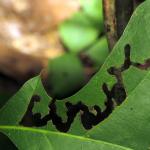
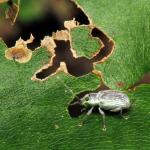 Asiatic Oak Weevil: Cyrtepistomus castaneus is a ¼ to 1/3 inch long weevil that was first introduced into the US in 1933. It now occurs throughout much of the eastern US. Small, legless larvae overwinter near the roots of their host plants, and are in that life stage through the fall, winter, and spring. Pupation occurs as temperatures warm in the spring and adults emerge to feed on newly expanding leaves of oak and chestnut. Adults may emerge as early as May, with abundance peaking in late June and early July. Feeding by the Asiatic oak weevil starts on the margins of their host plant leaves and is sometimes so severe that everything is devoured except the major veins. Adults lay their eggs in the soil starting in July and continue into the fall. This non-native insect has become naturalized and can sometimes be seen feeding on its host plants. Images of the weevil and its feeding were submitted to UMass Extension by Dr. Jennifer Forman Orth, MA Department of Agricultural Resources, from Worcester, MA.
Asiatic Oak Weevil: Cyrtepistomus castaneus is a ¼ to 1/3 inch long weevil that was first introduced into the US in 1933. It now occurs throughout much of the eastern US. Small, legless larvae overwinter near the roots of their host plants, and are in that life stage through the fall, winter, and spring. Pupation occurs as temperatures warm in the spring and adults emerge to feed on newly expanding leaves of oak and chestnut. Adults may emerge as early as May, with abundance peaking in late June and early July. Feeding by the Asiatic oak weevil starts on the margins of their host plant leaves and is sometimes so severe that everything is devoured except the major veins. Adults lay their eggs in the soil starting in July and continue into the fall. This non-native insect has become naturalized and can sometimes be seen feeding on its host plants. Images of the weevil and its feeding were submitted to UMass Extension by Dr. Jennifer Forman Orth, MA Department of Agricultural Resources, from Worcester, MA.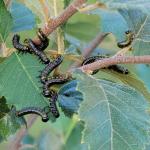
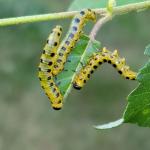 Dusky Birch Sawfly: Croesus latitarsus is a species of sawfly that feeds primarily on birch. Black, gray, Japanese white, paper, red, river, and yellow birch may all be suitable host plants. 1-2 generations occur per year, with the winter spent as a prepupa in a cocoon in the soil. Pupation occurs in the spring, with adult sawflies emerging in May. Eggs are laid and larvae are active roughly between April-May for the 1st generation and again in mid-July to mid-September in the 2nd generation. These sawfly caterpillars feed on the foliage of their hosts. Small trees may be defoliated; however, numbers of this species rarely reach levels where chemical intervention is necessary. Sawflies in this same genus are reportedly parasitized by Compsilura concinnata; however no natural enemies specific to the dusky birch sawfly have been reported. It is recommended that you leave these caterpillars alone if they can be tolerated in your landscape. Not only are they important wildlife themselves, but they may be food for other wildlife such as birds. These beautiful photos of the dusky birch sawfly were taken by Ryan Fawcett, MA Department of Conservation and Recreation, on river birch on 9/18/2023.
Dusky Birch Sawfly: Croesus latitarsus is a species of sawfly that feeds primarily on birch. Black, gray, Japanese white, paper, red, river, and yellow birch may all be suitable host plants. 1-2 generations occur per year, with the winter spent as a prepupa in a cocoon in the soil. Pupation occurs in the spring, with adult sawflies emerging in May. Eggs are laid and larvae are active roughly between April-May for the 1st generation and again in mid-July to mid-September in the 2nd generation. These sawfly caterpillars feed on the foliage of their hosts. Small trees may be defoliated; however, numbers of this species rarely reach levels where chemical intervention is necessary. Sawflies in this same genus are reportedly parasitized by Compsilura concinnata; however no natural enemies specific to the dusky birch sawfly have been reported. It is recommended that you leave these caterpillars alone if they can be tolerated in your landscape. Not only are they important wildlife themselves, but they may be food for other wildlife such as birds. These beautiful photos of the dusky birch sawfly were taken by Ryan Fawcett, MA Department of Conservation and Recreation, on river birch on 9/18/2023.
Current Nuisance Problems of Note:
- Deer Tick/Blacklegged Tick: Ixodes scapularis adults are active all winter and spring, as they typically are from October through May, and “quest” or search for hosts at any point when daytime temperatures are above freezing. Engorged females survive the winter and lay 1,500+ eggs in the forest leaf litter beginning around Memorial Day (late May). For images of all deer tick life stages, along with an outline of the diseases they carry, visit: https://www.capecod.gov/departments/cooperative-extension/programs/ticks-bugs/ or https://web.uri.edu/tickencounter/species/blacklegged-tick/.
Anyone working in the yard and garden should be aware that there is the potential to encounter deer ticks. The deer tick or blacklegged tick can transmit Lyme disease, human babesiosis, human anaplasmosis, and other diseases. Preventative activities, such as daily tick checks, wearing appropriate clothing, and permethrin treatments for clothing (according to label instructions) can aid in reducing the risk that a tick will become attached to your body. If a tick cannot attach and feed, it will not transmit disease. For more information about personal protective measures, visit: https://www.capecod.gov/departments/cooperative-extension/programs/ticks-bugs/.
The Center for Agriculture, Food, and the Environment provides a list of potential tick identification and testing resources.
*In the news: UMass Amherst has now been designated as the location for the New England Center of Excellence in Vector-Borne Diseases (NEWVEC). This CDC (Centers for Disease Control and Prevention) funded center will work to reduce the risk of vector-borne diseases spread by ticks, mosquitoes, and other blood-sucking insects or insect relatives in New England. For more information and to contact NEWVEC, visit: https://www.newvec.org/. To contact the center for more information about their Spring 2023 Project ITCH (“Is Tick Control Helping”), visit: https://www.newvec.org/itch .
- Mosquitoes: According to the Massachusetts Bureau of Infectious Disease and Laboratory Science and the Department of Public Health, there are at least 51 different species of mosquito found in Massachusetts. Mosquitoes belong to the Order Diptera (true flies) and the Family Culicidae (mosquitoes). As such, they undergo complete metamorphosis, and possess four major life stages: egg, larva, pupa, and adult. Adult mosquitoes are the only stage that flies and many female mosquitoes only live for 2 weeks (although the life cycle and timing will depend upon the species). Only female mosquitoes bite to take a blood meal, and this is so they can make eggs. Mosquitoes need water to lay their eggs in, so they are often found in wet or damp locations and around plants. Different species prefer different habitats. It is possible to be bitten by a mosquito at any time of the day, and again timing depends upon the species. Many are particularly active from just before dusk, through the night, and until dawn. Mosquito bites are not only itchy and annoying, but they can be associated with greater health risks. Certain mosquitoes vector pathogens that cause diseases such as West Nile virus (WNV) and eastern equine encephalitis (EEE).
Click here for more information about mosquitoes in Massachusetts.
EEE and WNV testing and tracking for this season began on June 12, 2023. The Massachusetts Department of Public Health tracks animal cases, human cases, and mosquito positive samples from traps from June through October in Massachusetts. The first West Nile Virus positive mosquito sample was collected on July 6, 2023, in the town of Brookline in Norfolk County, MA. Click here for more information.
As of September 21, 2023, 138 positive WNV mosquito samples have been collected in the state. See the previous link for specific locations.
As of 9/20/2023, 3 human cases of WNV have been reported in Massachusetts: https://www.mass.gov/news/state-health-officials-announce-first-two-human-cases-of-west-nile-virus-in-massachusetts.
The first eastern equine encephalitis (EEE) positive mosquito samples for 2023 were detected in Massachusetts as of 9/1/2023: https://www.mass.gov/news/state-public-health-officials-announce-seasons-first-eee-positive-mosquito-samples. As of September 21, 2023, 12 positive EEE mosquito samples have been collected in the state. See the previous link for specific locations.
There are ways to protect yourself against mosquitoes, including wearing long-sleeved shirts and long pants, keeping mosquitoes outside by using tight-fitting window and door screens, and using insect repellents as directed. Products containing the active ingredients DEET, permethrin, IR3535, picaridin, and oil of lemon eucalyptus provide protection against mosquitoes. Be aware that not all of these can be safely used on young children. Read and follow all label instructions for safety and proper use.
Click here for more information about mosquito repellents.
- Wasps/Hornets: Many wasps are predators of other arthropods, including pest insects such as certain caterpillars that feed on trees and shrubs. Adult wasps hunt prey and bring it back to their nest where young are being reared, as food for the immature wasps. A common such example are the paper wasps (Polistes spp.) who rear their young on chewed up insects. They may be seen searching plants for caterpillars and other soft-bodied larvae to feed their young. Paper wasps can sting, and will defend their nests, which are open-celled paper nests that are not covered with a papery “envelope”. These open-celled nests may be seen hanging from eaves or other outdoor building structures. Aerial yellow jackets and hornets create large aerial nests that are covered with a papery shell or “envelope”. Common yellow jacket species include those in the genus Vespula. Dolichovespula maculata is commonly known as the baldfaced hornet, although it is not a true hornet. The European hornet (Vespa crabro) is three times the size of a yellow jacket and may be confused for the northern* giant hornet (Vespa mandarinia). The European hornet is known to Massachusetts, but the northern giant hornet is not. European hornets have black, tear-drop shaped markings on their abdomens, but northern giant hornets do not. If you are concerned that you have found or photographed a northern giant hornet, please report it here: https://massnrc.org/pests/report.aspx. Recent articles in the news have homeowners concerned about a new invasive species of hornet that is closely related to the northern giant hornet. The yellow-legged hornet (Vespa velutina) has been detected in Georgia as of August 2023. The yellow-legged hornet is native to Southeast Asia and smaller than the northern giant hornet. There is concern that the yellow-legged hornet, if allowed to establish in the USA, could pose a threat to honeybee health. More information can be found here: https://agr.georgia.gov/yellow-legged-hornet . If you suspect you’ve seen the yellow-legged hornet in Massachusetts, take a photo and submit a report here: https://massnrc.org/pests/report.aspx .
Paper wasps and aerial yellowjackets overwinter as fertilized females (queens) and a single female produces a new nest annually in the late spring. Queens start new nests, lay eggs, and rear new wasps to assist in colony/nest development.Nests are abandoned at the end of the season. Some people are allergic to stinging insects, so care should be taken around wasp/hornet nests. Unlike the European honeybee (Apis mellifera), wasps and hornets do not have barbed stingers, and therefore can sting repeatedly when defending their nests. It is best to avoid them, and if that cannot be done and assistance is needed to remove them, consult a professional.
*Read more about the common name change for Vespa mandarinia.
Woody ornamental insect and non-insect arthropod pests to consider, a selected few:
Highlighted Invasive Insects & Other Organisms Update:
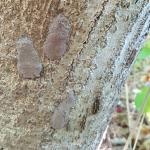 Spotted Lanternfly: (Lycorma delicatula, SLF) is a non-native, invasive insect that feeds on over 103 species of plants, including many trees and shrubs that are important in our landscapes. As of September 2023, the MA Department of Agricultural Resources (MDAR) has announced three additional populations of spotted lanternfly in Massachusetts. This brings the total locations of established populations of spotted lanternfly in Massachusetts to: Fitchburg, Shrewsbury, Worcester, Springfield, Holyoke, Agawam, and Southborough, MA.
Spotted Lanternfly: (Lycorma delicatula, SLF) is a non-native, invasive insect that feeds on over 103 species of plants, including many trees and shrubs that are important in our landscapes. As of September 2023, the MA Department of Agricultural Resources (MDAR) has announced three additional populations of spotted lanternfly in Massachusetts. This brings the total locations of established populations of spotted lanternfly in Massachusetts to: Fitchburg, Shrewsbury, Worcester, Springfield, Holyoke, Agawam, and Southborough, MA.
As a reminder, there is no reason to be preemptively treating for this insect in other areas of Massachusetts. If you suspect you have found spotted lanternfly in additional locations, please report it immediately to MDAR here. If you are living and working in the above listed areas, please be vigilant and continue to report anything suspicious. Additionally, information about managing spotted lanternfly is provided in the Spotted Lanternfly Management Guide for Professionals, below.
For More Information:
From UMass Extension:
Spotted Lanternfly Management Guide for Professionals
*Note that management may only be necessary in areas where this insect has become established in Massachusetts and if high value host plants are at risk. Preemptive management of the spotted lanternfly is not recommended.
Check out the InsectXaminer Episode about spotted lanternfly adults and egg masses!
From the MA Department of Agricultural Resources (MDAR):
Spotted Lanternfly Fact Sheet and Map of Locations in MA
Spotted Lanternfly Management Guide for Homeowners in Infested Areas
*New*: Spotted Lanternfly Look-alikes in MA
*New*: Spotted Lanternfly Egg Mass Look-alikes
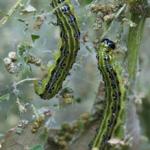
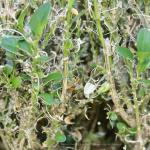 Box Tree Moth: staff with the Mass. Dept. of Agricultural Resources (MDAR) and the USDA have recently confirmed several instances of boxwood shrubs on Cape Cod that were infested with the invasive pest known as box tree moth (Cydalima perspectalis). The finds have all been in established plantings (2 years old or more). It is unclear how the moths were introduced to the area or how widespread this pest is; USDA is currently working to delimit the infestation.
Box Tree Moth: staff with the Mass. Dept. of Agricultural Resources (MDAR) and the USDA have recently confirmed several instances of boxwood shrubs on Cape Cod that were infested with the invasive pest known as box tree moth (Cydalima perspectalis). The finds have all been in established plantings (2 years old or more). It is unclear how the moths were introduced to the area or how widespread this pest is; USDA is currently working to delimit the infestation.
The main host of box tree moth is boxwoods (Buxus spp.), though in their native range, the moths will also attack burning bush (Euonymus alatus) and a few other uncommon species, if boxwood is not available. The late-stage caterpillars cause significant defoliation and should be detectable now: check boxwoods for greenish brown caterpillars, 1 to 1.5 inches long, with black stripes running from head to tip, black heads, and long hairs scattered along the body. The caterpillars form webbing in the boxwoods to protect themselves, and in a heavy infestation this webbing fills up with visible clumps of frass pellets (waste material).
Box tree moths can cause complete defoliation of boxwoods, eventually killing entire shrubs. We encourage you to review the following fact sheet from the USDA to learn more about this pest, including how to recognize the adult moths, caterpillars, and eggs: Box Tree Moth Pest Alert
If you grow, sell, or install boxwoods, please inspect them for any signs of this pest, and report any finds to https://massnrc.org/pests/report.aspx
More information about box tree moth, including management options, is now available from UMass Extension at: https://ag.umass.edu/landscape/fact-sheets/box-tree-moth.
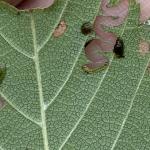
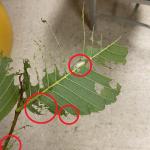
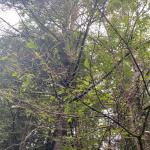 Elm Zigzag Sawfly: (Aproceros leucopoda) is a nonnative insect that originated in eastern Asia (Japan and certain regions of China). It is now invasive in Europe (2003) and North America. The elm zigzag sawfly has been found in Virginia (2021), Maryland, Pennsylvania, North Carolina, New York, and Vermont. In 2023, the elm zigzag sawfly was detected for the first time in a small, forested area of Berkshire and Hampden Counties in Massachusetts: https://www.mass.gov/news/dcr-announces-that-elm-zigzag-sawfly-has-been-confirmed-in-massachusetts. Significant defoliation of elm host plants was seen at the impacted locations. It is currently unclear how widespread the elm zigzag sawfly is in Massachusetts or how the infestation was introduced.
Elm Zigzag Sawfly: (Aproceros leucopoda) is a nonnative insect that originated in eastern Asia (Japan and certain regions of China). It is now invasive in Europe (2003) and North America. The elm zigzag sawfly has been found in Virginia (2021), Maryland, Pennsylvania, North Carolina, New York, and Vermont. In 2023, the elm zigzag sawfly was detected for the first time in a small, forested area of Berkshire and Hampden Counties in Massachusetts: https://www.mass.gov/news/dcr-announces-that-elm-zigzag-sawfly-has-been-confirmed-in-massachusetts. Significant defoliation of elm host plants was seen at the impacted locations. It is currently unclear how widespread the elm zigzag sawfly is in Massachusetts or how the infestation was introduced.
Female elm zigzag sawflies cause a tiny amount of damage to the edges of host plant leaves as they lay their eggs. Tiny scars are formed as a result of female egg laying. Eggs hatch and young sawfly caterpillars (the most destructive life stage of the insect) begin their characteristic zig-zag patterned feeding. These zig-zag shaped notches in the leaf can extend 5-10 mm into the leaf from the edge. Multiple caterpillars can feed on a single leaf. Entire leaves can be completely stripped, leaving only the veins behind. Heavily infested trees can suffer partial or complete defoliation.
If you suspect you have found elm zigzag sawfly in Massachusetts, please report it to Nicole Keleher (Massachusetts Department of Conservation and Recreation, Forest Health Program), Nicole.Keleher@mass.gov, or to the MA Dept. of Agricultural Resources at https://massnrc.org/pests/report.aspx.
More information about the elm zigzag sawfly, including management options, is now available from UMass Extension at: https://ag.umass.edu/landscape/fact-sheets/elm-zigzag-sawfly.
- Southern Pine Beetle: Dendroctonus frontalis has been collected in traps in Massachusetts and other parts of New England in recent years. Historically, the southern pine beetle has been native to the southeastern United States, however its range is moving northward due to warming winters and climate change. The Massachusetts Department of Conservation and Recreation (DCR) Forest Health Program, has announced that they have detected the first pocket of southern pine beetle killed trees (pitch pine, Pinus rigida) in Massachusetts on Nantucket. This is the first observation of this species killing trees in the state. An active infestation of southern pine beetle was found killing trees in July and MA DCR is working with the property owner to determine next steps and potential management options at the site. If you believe you have detected southern pine beetles in trees in Massachusetts, please contact Nicole Keleher, MA DCR Forest Health Director, at: nicole.keleher@mass.gov. More information about southern pine beetle is also available from MA DCR at https://storymaps.arcgis.com/stories/b60f63199fa14805a8b9f7c82447a25b .
The southern pine beetle (SPB) undergoes complete metamorphosis (is holometabolous) with four life stages: egg, larva, pupa, and adult. Adults are dark red/brown to black in color and 1/16 – 1/8” in length. Eggs are white and larvae are crescent-shaped with a dark red/brown head and a white body. Four larval instars are present, with pupa being bright white. The adult is light brown in color prior to drying and hardening and becoming darker in color. Female beetles select suitable host trees and release chemical pheromones to attract male mates. She will penetrate the bark and begin creating a gallery where she is joined by the male and mates. Early attacks to the tree may be “pitched out” by the resin defenses of the tree. The pheromones produced by the females and the volatile chemicals expressed by the stressed host plant attract additional males and females. If tree defenses can be overcome, females will colonize beneath the bark, creating S-shaped galleries. The inoculation of the tree with a blue stain fungus as well as other fungi occurs with colonization of southern pine beetle, however, it is the act of "mass attack" by the insects themselves which leads to tree mortality. Entomocorticium spp. symbiotic fungi are associated with southern pine beetles and the immature larvae feed on this fungus. Females may lay up to 160 eggs in their lifetime and development can take as little as 26 days in warmer climates. In the South, 3-9 generations of SPB have been observed to occur per year. In NY, 3-4 generations have been observed on Long Island. Current Massachusetts temperatures should keep the number of generations per year to the lower end of this range.
Southern pine beetle can be detected most easily by the presence of popcorn-sized pitch tubes on the outer bark of trunks and branches. Pitch tubes can range in color from white to red. They can occur from ground level to high in the canopy of the tree. Exit holes (about 1/16” in diameter) can be observed in the bark from emerging adults. S-shaped galleries can also be observed by peeling back any bark that may be falling off the tree. Brown-orange frass (excrement) that looks like wood shavings is found packed within the galleries. By the time foliage fades from green to yellow to brown, the infestation may be advanced. The presence of certain checkered or clerid beetles can also indicate high populations of southern pine beetle, as these checkered beetles prey upon SPB. Southern pine beetle prefers trees damaged by lightning strikes or fire. In the southeastern part of the insect's range, southern pine beetle is not known to preferentially attack drought stressed or chronically stressed trees. Trees under 15 years of age or 2 inches in diameter may be seldom attacked.
- Asian Longhorned Beetle: (Anoplophora glabripennis, ALB) Look for signs of an ALB infestation which include perfectly round exit holes (about the size of a dime), shallow oval or round scars in the bark where a female has chewed an egg site, or sawdust-like frass (excrement) on the ground nearby host trees or caught in between branches. Be advised that other, native insects may create perfectly round exit holes or sawdust-like frass, which can be confused with signs of ALB activity.
Adult Asian longhorned beetles typically begin to emerge from trees by July 1st in Massachusetts. It is important to take photographs of and report any suspicious longhorned beetles to the Asian Longhorned Beetle Eradication Program phone numbers listed below.
The regulated area for Asian longhorned beetle is 110 square miles encompassing Worcester, Shrewsbury, Boylston, West Boylston, and parts of Holden and Auburn. If you believe you have seen damage caused by this insect, such as exit holes or egg sites, on susceptible host trees like maple, please call the Asian Lonbghorned Beetle Eradication Program office in Worcester, MA at 508-852-8090 or toll free at 1-866-702-9938.
Report an Asian longhorned beetle find online or compare it to common insect look-alikes here.
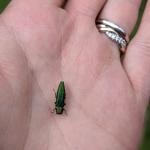 Emerald Ash Borer: (Agrilus planipennis, EAB) has been detected throughout much of Massachusetts and it was recently detected for the first time in Barnstable County. A map of these locations across the state is provided by the MA Department of Conservation and Recreation at https://storymaps.arcgis.com/stories/b60f63199fa14805a8b9f7c82447a25b.
Emerald Ash Borer: (Agrilus planipennis, EAB) has been detected throughout much of Massachusetts and it was recently detected for the first time in Barnstable County. A map of these locations across the state is provided by the MA Department of Conservation and Recreation at https://storymaps.arcgis.com/stories/b60f63199fa14805a8b9f7c82447a25b.
This wood-boring beetle readily attacks ash (Fraxinus spp.) including white, green, and black ash and has also been found developing in white fringe tree (Chionanthus virginicus) and has been reported in cultivated olive (Olea europaea). Signs of an EAB infested tree may include D-shaped exit holes in the bark (from adult emergence), “blonding” or lighter coloration of the ash bark from woodpecker feeding (chipping away of the bark as they search for larvae beneath), and serpentine galleries visible through splits in the bark, from larval feeding beneath. It is interesting to note that woodpeckers are capable of eating 30-95% of the emerald ash borer larvae found in a single tree (Murphy et al. 2018). Unfortunately, despite high predation rates, EAB populations continue to grow. However, there is hope that biological control efforts will eventually catch up with the emerald ash borer population and preserve some of our native ash tree species for the future.
- Jumping Worms: Amynthas spp. earthworms, collectively referred to as “jumping or crazy or snake” worms, overwinter as eggs in tiny, mustard-seed sized cocoons found in the soil or other substrate (ex. compost). Immature jumping worms hatch from their eggs by approximately mid-to-late May. It may be impossible to see them at first, and it may be more likely that jumping worms are noticed when the first adults begin to appear at the end of May and in June. It is easy to misidentify jumping worms (ex. mistake European earthworms for jumping worms) if only juveniles are found. In August and September, most jumping worms have matured into the adult life stage and identification of infestations is more likely to occur at that time of year.
For More Information, see these UMass Extension Fact Sheets:
Earthworms in Massachusetts – History, Concerns, and Benefits
Jumping/Crazy/Snake Worms – Amynthas spp.
A Summary of the Information Shared at UMass Extension’s Jumping Worm Conference in January 2022
Invasive Jumping Worm Frequently Asked Questions (Over 70 Questions and their Answers)
Tree & Shrub Insect Pests (Native and Invasive):
- Ailanthus Webworm: Atteva aurea (formerly A. punctella) is a tropical ermine moth from the family Attevidae. While they may be referred to as tropical, apparently the moths themselves can tolerate much colder temperatures than their original host plants. Prior to 1784 when tree of heaven (Ailanthus altissima) was introduced into Philadelphia, PA, the ailanthus webworm was restricted to southern Florida and points south. It would appear that this restriction in distribution was due to the distribution of their original host plants in the genus Simarouba. Once tree of heaven’s range extended from the north to the south including Florida, the moths were able to move northward on the newly available and suitable host plant. Larvae of this moth feed almost exclusively on tree of heaven in the northern parts of its expanded range. Occasionally, these caterpillars will defoliate tree of heaven, but not to the extent that they could provide any form of control of this invasive tree (on younger plants, sometimes caterpillars can completely defoliate the trees and strip the bark off of small branches). Larvae cluster together in a loose web. Larvae of the ailanthus webworm have five white longitudinal lines on an olive-brown colored base with sparsely hairy bodies. Caterpillars are found in the late summer. Larvae pupate within their webs; moths emerge, mate, and then lay their eggs on the outside of the webs. Multiple overlapping generations can occur per year.
- Andromeda Lace Bug: Stephanitis takeyai is most commonly encountered on Japanese Andromeda. Eggs are tiny and inserted into the midveins on the lower surface of the leaf and covered with a coating that hardens into a protective covering. 5 nymphal stages are reported. Nymphs are different in appearance from the adults, often covered with spiky protrusions. 3-4 generations per year have been observed in New England, with most activity seen between late-May into September (starting at approximately 120 GDD’s, Base 50°F). Both nymphs and adults can be seen feeding on leaf undersides. Adults have delicate, lace-like wings and what appears to be an "inflated hood" that covers their head. Adults are approximately 1/8 of an inch long. Arrived in the US in Connecticut in 1945 from Japan (Johnson and Lyon, 1991).
Can cause severe injury to Japanese andromeda, especially those in full sun. Mountain Andromeda (Pieris floribunda) is highly resistant to this pest. Like other lace bugs, this insect uses piercing-sucking mouthparts to drain plant fluids from the undersides of the leaves. Damage may be first noticed on the upper leaf surface, causing stippling and chlorosis (yellow or off-white coloration). Lace bug damage is distinguished from that of other insects upon inspecting the lower leaf surface for black, shiny spots, "shed" skins from the insects, and adult and nymphal lace bugs themselves.
A first sign of potential lace bug infestation is stippling or yellow/white colored spots or chlorosis on host plant leaf surfaces. Lace bugs excrete a shiny, black, tar-like excrement that can often be found on the undersides of infested host plant leaves. Flip leaves over to inspect for this when lace bug damage is suspected.
Mountain Andromeda (Pieris floribunda) is considered to be highly resistant to this insect and can be used as an alternative for such plantings, along with other lace bug-resistant cultivars. Consider replacing Japanese Andromeda with mountain andromeda as a way to manage for this pest. Natural enemies are usually predators, and sometimes not present in large enough numbers in landscapes to reduce lace bug populations. Structurally and (plant) species complex landscapes have been shown to reduce azalea lace bug (Stephanitis pyrioides) populations through the increase of natural enemies
- Fall Home-Invading Insects: Various insects, such as ladybugs, boxelder bugs, seedbugs, and stink bugs will begin to seek overwintering shelters in warm places, such as homes, throughout the next couple of months. While such invaders do not cause any measurable structural damage, they can become a nuisance especially when they are present in large numbers. While the invasion has not yet begun, if you are not willing to share your home with such insects, now should be the time to repair torn window screens, repair gaps around windows and doors, and sure up any other gaps through which they might enter the home.
- Hickory Tussock Moth: Lophocampa caryae is native to southern Canada and the northeastern United States. There is one generation per year. Overwintering occurs as a pupa inside a fuzzy, oval shaped cocoon. Adult moths emerge approximately in May and their presence can continue into July. Females will lay clusters of 100+ eggs together on the underside of leaves. Females of this species can fly, however they have been called weak fliers due to their large size. When first hatched from their eggs, the young caterpillars will feed gregariously in a group, eventually dispersing and heading out on their own to forage. Caterpillar maturity can take up to three months and color changes occur during this time. These caterpillars are essentially white with some black markings and a black head capsule. They are very hairy, and should not be handled with bare hands as many can have skin irritation or rashes (dermatitis) as a result of interacting with hickory tussock moth hairs. By late September, the caterpillars will create their oval, fuzzy cocoons hidden in the leaf litter where they will again overwinter. Hosts whose leaves are fed upon by these caterpillars include but are not limited to hickory, walnut, butternut, linden, apple, basswood, birch, elm, black locust, and aspen. Maple and oak have also been reportedly fed upon by this insect. Several wasp species are parasitoids of hickory tussock moth caterpillars.
- Mimosa Webworm: Homadaula anisocentra was first detected in the United States in 1940 in Washington, D.C. on its common namesake host plant. Originally from China, the mimosa webworm is primarily a pest of honeylocust (Gleditsia triacanthos; including thornless cultivars). This insect is found throughout the eastern and midwestern states and California. In the warmer parts of its range in the United States, it has historically heavily attacked mimosa where it grows. Adults are moths that are silvery gray in color with wings interrupted by black dots. Moths are approximately 13 mm in size (wingspan). Fully grown larvae reach up to 16 mm long and are variable in color from gray to brown with five longitudinal white stripes. Once mature, the caterpillars move to the bark scales of their host plants and find sheltered places to pupate. They may also be found in the leaf litter beneath host plants, pupating in a cocoon. Pupae are yellowish brown, 6 mm long, and encased in a white cocoon. Adult moths may emerge in early-mid June and lay gray eggs on the leaves of their hosts that turn a rose color just prior to hatch. Eggs hatch and feeding caterpillars web the foliage together, feeding within the web for protection. Larvae may be found feeding together in groups, in which case larger and aesthetically displeasing webs may be created. If disturbed, the larvae may move quickly and can drop from the web on a line of silk. A second generation of moths may occur, with pupation happening and adults emerging by August in warmer locations. In New York and New England, it is likely that this second generation emerges in September and any offspring may be killed with the winter. In the warmest parts of this insect's introduced range in the United States, three generations may be possible per year.
The larvae (caterpillars) of this insect tie the foliage of their hosts together with silken strands and skeletonize the leaves. Injury to host plant leaves may be noticeable by early July in Massachusetts. Foliage can appear bronzed in color from the feeding. Webbing usually begins at the tops of trees. An entire tree may become covered in the webs created by these caterpillars. So much webbing can often make it difficult to assess the extent of the defoliation or damage caused on an individual host.
Certain cultivars of honeylocust may vary in their susceptibility to this insect. Gleditsia triacanthos 'Sunburst' was highly susceptible to attack in Indiana. Cultivars such as 'Moraine', 'Shademaster', and 'Imperial' may be less susceptible - however, they are still able to be fed upon by this insect, so annual monitoring may be necessary.
- Redheaded Pine Sawfly: Neodiprion lecontei can be an important native pest of ornamental, forest, and plantation pines. Jack, shortleaf, loblolly, slash, red, and other two and three-needle pines are suitable hosts and occasionally others in proximity to these. This insect overwinters as a prepupa in a cocoon in the leaf litter near is hosts. Pupation occurs in the spring and adults emerge a few weeks later. Some prepupae have delayed emergence, which can occur 2 or 3 years later. Females lay over 100 eggs in rows of slits in the edges of several needles. Egg laying can take place without mating, with unfertilized eggs producing males. Fertilized eggs produce males and females. Larvae hatch in a month and feed gregariously. Eventually, they drop to the ground to spin overwintering cocoons. Historically in New England, a single generation occurred per year. In more southern parts of its range, 2-3 generations may occur annually. Anecdotally, as the growing season and winters warm in New England due to climate change, it seems a second generation of this insect is possible and may already be occurring. Natural enemies include rodent predators of the pupae as well as diseases of the larvae.
Concerned that you may have found an invasive insect or suspicious damage caused by one? Need to report a pest sighting? If so, please visit the Massachusetts Introduced Pests Outreach Project.
Reported by Tawny Simisky, Extension Entomologist, UMass Extension Landscape, Nursery, & Urban Forestry Program
Landscape Weeds
Japanese knotweed in most areas in New England is near the end of its flowering period. There is time to treat knotweed as long as the leaves are still green. Applications of glyphosate are the best choice for Japanese knotweed management. For areas near and around water, you will need to use a glyphosate formulation that is labeled for these areas. Since knotweed commonly grows in wet areas or near streams, rivers or wetlands, the management of this invasive plant may invoke 310 CMR 10.00 (the Massachusetts Wetlands Protection Act). 310 CMR 10.00 regulates all activities in the resource areas identified in the act. Before any management attempts are carried out, you should contact the Conservation Commission in the municipality to determine to what extent 310 CMR 10.00 might impact your project. For states other than Massachusetts, you should seek information about that state’s regulation for activities near water.
Common reed or phragmites, Phragmites australis, is in flower in New England, so now is the time for herbicide treatment. Glyphosate-based herbicide products are the best choice for the control of common reed. In areas near water, a formulation of glyphosate that is labeled for these areas should be used. Since common reed is most commonly associated with water and wet habits, 310 CMR 10.00 (the Massachusetts Wetlands Protection Act) might be invoked. See comments in the Japanese knotweed section above for details about 310 CMR 10.00.
Poison ivy is in fruit and should be treated now. Glyphosate or triclopyr are the best herbicides for poison ivy control. Triclopyr products should be selected over glyphosate in areas where grasses need to be saved. Contact (ScytheTM, RewardTM) or the non-chemical/organic herbicide products will provide “burndown” activity only and will not adequately control poison ivy. REMEMBER, the oil in poison ivy, known as urushiol, is still active in the plant after the plant is dead and can still cause contact dermatitis. Urushiol occurs in all parts of the plant, including the roots.
Many winter annual weeds will be germinating in the next month and a half, so now is the time to mulch landscape beds or areas that are known to have populations of winter annual weeds. Some common landscape winter annual weeds are:
- mouse-ear cress (Arabidopsis thaliana)
- thymeleaf sandwort (Arenaria serpyllifolia)
- downy brome (Bromus tectorum)
- shepherd's-purse (Capsella bursa-pastoris)
- bittercress (Cardamine hirsuta)
- sticky chickweed (Cerastium viscosum)
- horseweed (Conyza canadensis)
- spring whitlowgrass (Draba verna)
- henbit (Lamium amplexicaule)
- red deadnettle (Lamium purpureum)
- field pepperweed (Lepidium campestre)
- Virginia pepperweed (Lepidium virginicum)
- pineappleweed (Matricaria matricariodes)
- annual bluegrass (Poa annua)
- knawel (Scleranthus annuus)
- common chickweed (Stellaria media)
- field pennycress (Thlaspi arvense)
- corn speedwell (Veronica arvensis)
- purslane speedwell (Veronica peregrina)
For information about identification of these weeds, check out UMass Extension's Weed Herbarium: https://extension.umass.edu/weed-herbarium/
At this point in the season, summer annual weeds have become very large. Treating them with a non-selective herbicide will result in unsightly dead vegetation, so hand weeding may be necessary. Consider physical removal followed by a fresh mulch layer. This will cover any plants that could not be removed as well as provide protection against the winter annual weeds mentioned above.
Perennial grass and broadleaf weeds may be present in landscapes at this time of the season. As day length continues to shorten and bring cool weather, these weeds begin to move carbohydrates down into the roots, rhizomes and crowns. Applications of a translocated, non-selective herbicide will effectively move with this downward flow and increase herbicide efficacy on these perennial weeds. Directed-spray application of a glyphosate product is an excellent choice. To minimize spray-drift injury, applications should be made when there is little to no air movement and spray should be adjusted to applied a coarse spray.
Reported by Randy Prostak, Weed Specialist, UMass Extension Landscape, Nursery, & Urban Forestry Program
Additional Resources
Pesticide License Exams - The MA Dept. of Agricultural Resources (MDAR) is now holding exams online. For more information and how to register, go to: https://www.mass.gov/pesticide-examination-and-licensing.
To receive immediate notification when the next Landscape Message update is posted, join our e-mail list or follow us on Facebook.
For a complete listing of landscape, nursery, and urban forestry program upcoming events, see our calendar at https://ag.umass.edu/landscape/upcoming-events.
For commercial growers of greenhouse crops and flowers - Check out UMass Extension's Greenhouse Update website.
For professional turf managers - Check out our Turf Management Updates.
For home gardeners and garden retailers - Check out our home lawn and garden resources.
Diagnostic Services
UMass Laboratory Diagnoses Landscape and Turf Problems - The UMass Extension Plant Diagnostic Lab is available to serve commercial landscape contractors, turf managers, arborists, nurseries and other green industry professionals. It provides woody plant and turf disease analysis, woody plant and turf insect identification, turfgrass identification, weed identification, and offers a report of pest management strategies that are research based, economically sound and environmentally appropriate for the situation. Accurate diagnosis for a turf or landscape problem can often eliminate or reduce the need for pesticide use. For sampling procedures, detailed submission instructions and a list of fees, see the Plant Diagnostic Laboratory web site.
Soil and Plant Nutrient Testing - The University of Massachusetts Soil and Plant Nutrient Testing Laboratory is located on the campus of the University of Massachusetts at Amherst. Testing services are available to all. The lab provides test results and recommendations that lead to the wise and economical use of soils and soil amendments. For more information, including current turn-around times, visit the UMass Soil and Plant Nutrient Testing Laboratory web site. The lab is currently accepting orders for Routine Soil Analysis (including optional Organic Matter, Soluble Salts, and Nitrate testing), Particle Size Analysis, Pre-Sidedress Nitrate (PSNT), Total Sorbed Metals, and Soilless Media (no other types of soil analyses available at this time). Check for current turnaround time. Please plan for the fact that date of receipt in the lab is affected by weekends, holidays, shipping time, and time for UMass Campus Mail to deliver samples to the lab.
Tick Testing - The UMass Center for Agriculture, Food, and the Environment provides a list of potential tick identification and testing options at: https://ag.umass.edu/resources/tick-testing-resources.
Acknowledgements: UMass Extension gratefully acknowledges the support of the following funding sources for the production of the Landscape Message –
- The Massachusetts Nursery and Landscape Association Fund
- The Massachusetts Department of Conservation and Recreation, Award #ISADCR28219926UMA23A
- Stakeholders like you! The Landscape Message is partially supported by educational program user fees.
